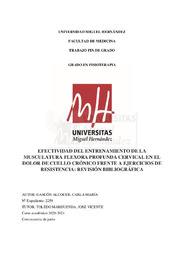Por favor, use este identificador para citar o enlazar este ítem:
https://hdl.handle.net/11000/25595
Efectividad del entrenamiento de la musculatura flexora profunda cervical en el dolor de cuello crónico frente a ejercicios de resistencia: Revisión bibliográfica
Título :
Efectividad del entrenamiento de la musculatura flexora profunda cervical en el dolor de cuello crónico frente a ejercicios de resistencia: Revisión bibliográfica |
Autor :
Gascón Alcocer, Carla María |
Tutor:
Toledo Marhuenda, José Vicente |
Editor :
Universidad Miguel Hernández de Elche |
Departamento:
Departamentos de la UMH::Patología y Cirugía |
Fecha de publicación:
2021-06-21 |
URI :
http://hdl.handle.net/11000/25595 |
Resumen :
Introducción; El dolor cervical es una afectación musculoesquelética frecuente considerada la cuarta causa de discapacidad, que provoca una disminución de la calidad de vida, afectando a la actividad y salud mental. Presenta una elevada prevalencia que muestra la necesidad de investigar acerca de su tratamiento.
Objetivo; Analizar la efectividad del entrenamiento de los flexores cervicales profundos (FCPs) frente a los ejercicios de resistencia, sobre el dolor y discapacidad asociada, en personas mayores de 18 años con dolor de cuello crónico inespecífico.
Material y métodos; La búsqueda se realizó en las bases científicas Pubmed y EMBASE, incluyendo ensayos clínicos desde el año 2016 hasta la febrero del 2021.
Resultados: 22 artículos coincidieron con los criterios de elegibilidad y se incluyeron en la revisión; 7 estaban relacionado con el Grupo FCPs y 18 para el grupo resistencia (GR), ya que 3 artículos combinaban ambas técnicas. El GR presenta 2 variantes: aquellos que solo incluyen ejercicios de resistencia cervical (GRC) y otros que combinan ejercicios cervicales y escapulares (GRCE).
Conclusiones; Ambas técnicas resultan ser efectivas para el tratamiento de esta patología, disminuyendo el dolor y la discapacidad por separado y aumentando su efecto cuando son aplicadas de forma multimodal. El GFCPs y el GRCE proveen una reducción de ambas medidas mayor que el GRC a corto plazo, pero GRCE presenta una disminución superior en el dolor que el GFCPs. Aunque son más necesarios más estudios para poder establecer un protocolo de actuación y determinar cuál sería la intervención más adecuada.
Introduction: Cervical pain is a frequent musculoskeletal involvement considered the fourth cause of disability, which causes a decrease in quality of life, affecting activity and mental health. It has a high prevalence that shows the need to investigate about its treatment.
Objective/s: To analyze the effectiveness of deep cervical flexor training (DCFTs) versus resistance exercises on associated pain and disability in people over 18 years of age with non-specific chronic neck pain.
Material and methods; The search was conducted in the Pubmed and EMBASE scientific bases, including clinical trials from 2016 to February 2021.
Results: 22 articles matched the eligibility criteria and were included in the review. Of these, 7 were related to the EFCPs group and 18 to the resistance group (GR), since 3 articles combined both techniques. The GR presents 2 variants: those that only include cervical resistance exercises (GRC) and others that combine cervical and scapular spine exercises (GRCE).
Conclusions: Both techniques prove to be effective for the treatment of this pathology, decreasing pain and disability separately and increasing their effect when applied multimodally. GFCPs and GRCE provide a greater reduction in both measures than GRC in the short term, but GRCE presents a greater reduction in pain than GFCPs. Although more studies are needed to establish an action protocol and determine the most appropriate intervention.
|
Palabras clave/Materias:
neck pain
cervicalgia
exercise
motor control
exercise Movement Techniques |
Área de conocimiento :
CDU: Ciencias aplicadas |
Tipo de documento :
info:eu-repo/semantics/bachelorThesis |
Derechos de acceso:
info:eu-repo/semantics/openAccess |
Aparece en las colecciones:
TFG - Fisioterapia
|
 La licencia se describe como: Atribución-NonComercial-NoDerivada 4.0 Internacional.
La licencia se describe como: Atribución-NonComercial-NoDerivada 4.0 Internacional.
 La licencia se describe como: Atribución-NonComercial-NoDerivada 4.0 Internacional.
La licencia se describe como: Atribución-NonComercial-NoDerivada 4.0 Internacional.
.png)
